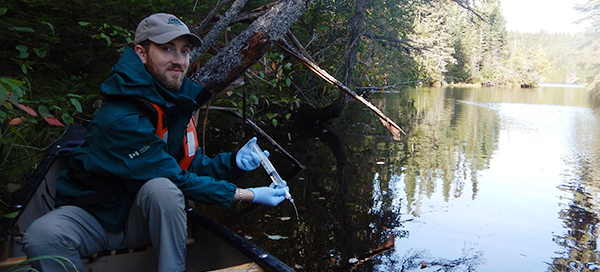
eDNA: From Crime to Conservation
Pukaskwa National Park
by Patrick Gilhooly
For over 30 years, forensic scientists have been using and refining the technique of DNA profiling used in crime scene investigations all over the world. It is a revolutionary tool and, more recently, wildlife conservation scientists have applied the technique of forensic DNA profiling to the natural world using environmental DNA (eDNA).
Environmental DNA is emerging as a new, powerful, and cost-effective tool to help answer pressing questions in conservation. For example, it can be used to identify the presence or absence of species at risk or invasive species in aquatic and terrestrial ecosystems.
Wildlife leave behind trace amounts of DNA in their environment through saliva, skin cells, feces, or other secretions. As a result, researchers are able to non-invasively collect eDNA through water, soil, ice, and even air samples to detect the presence of a single or multiple species.
More conventional population and assessment surveys, like physically trapping, are more invasive, time consuming, and usually expensive. eDNA can be used in combination with conventional survey methods to improve the effectiveness and efficiency of a study. For example, researchers may first determine where the species of interest is located geographically via eDNA sampling, and then use conventional population surveys in areas where it was detected to determine its abundance.
In an aquatic ecosystem, eDNA water samples from a river or lake are collected through a syringe fitted with a special filter that traps any genetic material present. The filter is removed and placed into a sterile container and either frozen or immersed in a chemical preservative, because DNA degrades quickly when exposed to sunlight or heat. The samples are sent to a laboratory for analysis. At the lab, trace amounts of eDNA are extracted from the filter. Then, DNA for the given species is amplified through a process called Polymerase Chain Reaction (PCR). With the help of a species-specific genetic primer (i.e. RNA), the PCR makes millions of copies of the target species’ DNA, allowing its presence to be identified among other non-target species’ genetic material.
The potential for eDNA in wildlife conservation efforts is enormous, as we seek to maintain the ecological integrity of our natural world for generations to come.
As a world leader in conservation, Parks Canada has been implementing eDNA projects across Canada as a tool to monitor species at risk and invasive species. For example, Riding Mountain National Park (Manitoba) has detected the presence of Zebra Mussels (Dreissena polymorpha), an aquatic invasive species, using eDNA. Kejimkujik National Park (Nova Scotia) is tracking the spread of the invasive Chain Pickerel (Esox niger) using eDNA water sampling.
At Pukaskwa National Park this fall, eDNA samples were taken at several locations in an effort to determine the presence of Snapping Turtles, a threatened species in Canada and Ontario. Lab results are expected later this winter.
Follow us on Twitter or Facebook to keep up to date on the latest developments.
- Date modified :